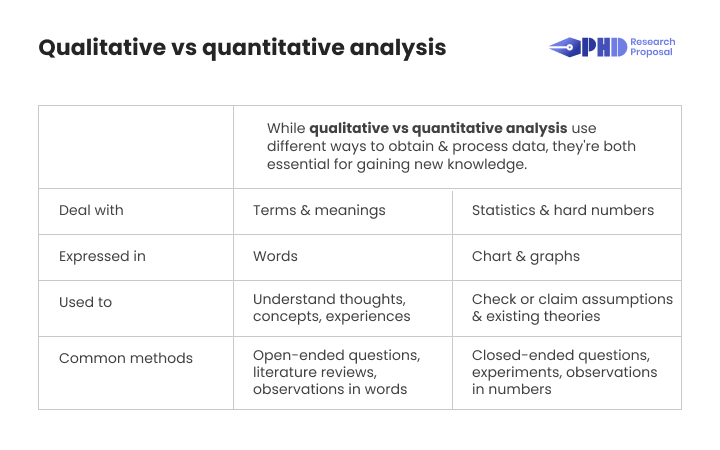What is the Difference Between Qualitative and Quantitative Analysis
The right choice of research methodology is the starting point of the project's success. So, let's dive in.

Explaining the Difference Between Qualitative and Quantitative Analysis
Every research project in academia involves some way of managing the collected information. Hence, the choice of qualitative vs quantitative analysis becomes actual. To choose the right methods, you need to understand the core meaning of each type of analysis.
Let’s briefly discuss the difference between qualitative and quantitative analysis.

Qualitative
- Uses words.
- Helpful when you need to get insights or clarify some unobvious moments.
- Some popular methods are ethnography, interviews, focus groups, and literature reviews.
- Question type: open-ended questions.
- Analysis types: categorization, generalization, interpretation.
- Often used for understanding something
Quantitative
- Uses numbers, graphs, and statistics.
- Helpful when you need to get general information on the topic.
- Some popular methods are experiments, observations in numbers, and surveys.
- Question type: close-ended questions.
- Analysis types: mathematical and statistical.
- Often used to test/confirm facts
As you can see, the difference between these research methods is evident. Still, they both have the same thing – the risk of particular biases. We consider them next to make it easier to choose one for qualitative research vs quantitative research.
How to Choose Quantitative vs Qualitative Research
The formulation of the research question and the objectives of the study are critical for good reason. The question and purpose are the key factors in choosing qualitative vs quantitative research methods for your project. If your PhD project aims to understand how something works, what reactions it triggers, and group this data, you need qualitative analysis. Quantitative analysis is the right choice if you must explore cause-and-effect connections, identify patterns, and count them.
But let’s mention that quantitative methods often go hand in hand with qualitative methods. Moreover, the way you collect, classify & organize data is the analysis itself, which is the basis for statistical data analysis. Furthermore, combining qualitative and quantitative research methods in the study is important for a complete and objective picture. This is known as a mixed modes approach.
Pitfalls of Qualitative Research Proposal to Consider
PhD investigations may have pitfalls or biases regardless of the chosen methodology. Here, we describe the most popular ones from all the possible biases. Considering them is essential both for the investigation process and data processing. You can also use them to get more information on the difference between qualitative and quantitative methods.
- Hawthorne Effect. This bias may occur when participants change their behavior after learning that they are part of a research study.
- Observer Bias. When researchers have their own expectations and beliefs, that might influence how they interpret collected results.
- Recall Bias. Research participants may recollect past events or experiences inaccurately or with distortions.
- Social Desirability Bias. This happens when participants try to present themselves in a positive light when answering questions or describing their experiences.
All of these biases can distort data, and making conclusions based on them would be a mistake. Such a study wouldn’t accurately reflect reality and couldn’t be the basis for valid conclusions. Therefore, it’s essential to consider all these types of biases when writing qualitative research proposal.
Obstacles of Quantitive Research Analysis to Consider
Like in the previous case, quantitative analysis has biases that can affect the results’ accuracy. In this section of the article, we’ll briefly go over them.
- Information bias. The analyst collects data that doesn’t reflect reality. This may have various reasons. For example, if the researcher asks participants questions they can’t or don’t want to answer correctly. The same happens when the analyst doesn’t consider all possible sources of information.
- Missing variable bias. The researcher doesn’t consider all the factors that could affect their study’s results. This way, they may make a wrong conclusion.
- Sampling bias. It happens when the analyst chooses participants for their study in a way that means the results of their study can’t be applied to everyone else.
- Selection bias. This happens when the researcher treats data differently. This can arise when the researcher pressures participants to answer in a certain way.
How do you reduce the risk of bias in quantitive and qualitative analysis methods to zero? You can avoid bias in quantitative analysis by following three principles:
- Objectivity in your approach to the study.
- Accuracy in collecting and analyzing data.
- The study’s completeness excludes the factors affecting the results.
How to Ask Research Questions for a Qualitative Research Proposal
As we mentioned before, the research question and goals are at the core of choosing the methodology. The way you frame your research question will determine the direction of your study and how you analyze your data.
How to ask research questions for a qualitative research proposal
If it comes to qualitative methodology, the question should be open-ended. This means that there should not be a single, definitive answer. You have to formulate a question relevant to your research topic in an easy-to-understand way.
How to ask research questions within a quantitative study
In turn, quantitative studies involve close-ended questions. They also can provide multiple choice. And while qualitative methods help provide the context, quantitative ones help test & experiment. If you’re still looking for a good topic, check out these quantitative research topics for inspiration!
Mixed Qualitative vs Quantitative Research Methods (MMR)
In some cases, it is necessary to use mixed quantitative vs qualitative research methods. It helps to get a complete overview of the study results. Using them together, this Mixed Methods Research (MMR) can provide the most comprehensive and objective results and allow for more accurate conclusions. The best combination for your research project will depend on the specific study.
There are many different combinations of MMR. However, the most common MMRs are:
- Convergent.
- Exploratory.
- Instrumental.
- Transformative.
In addition, depending on how you use the difference between quantitative research vs qualitative research and collected data in the study, they divide MMR into types based on their use. These include concurrent, sequential, and integrated use of MMR.
Need More Help With Your Qualitative Research Proposal?
When developing a PhD research design, you often choose between qualitative and quantitative analysis methods. The steps to decide are to ask the right questions and select the research object. But you don’t always have to. If MMR can help you get a more complete picture and make better conclusions, then it’s the way to go.
Today, we have explained what is the difference between qualitative and quantitative analysis. We hope you find it useful. But if you still have trouble with your PhD research proposal, there is always an option to get help from our experts. We can assist you with everything from the topic selection to polishing the finished copy. Just give us a direction and wait a little while we pick up the best-suited specialist.





